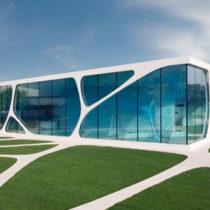Landscape Architecture for Landscape Architects › Forums › TECHNOLOGY › Is Revit the future for Landscape Architecture?
- This topic has 1 reply, 8 voices, and was last updated 15 years, 1 month ago by
 landplanner.
landplanner.
-
AuthorPosts
-
October 19, 2010 at 4:31 pm #167310
 Stefanie BiggarParticipant
Stefanie BiggarParticipantI am interested in finding out if Revit has become more popular amongst Landscape Architects and if product manufacturers (particularly site furniture) should start offering product libraries in Revit.
October 19, 2010 at 5:03 pm #167327 landplannerParticipant
landplannerParticipantI still think it will be some time (at least 1 to 2 years) before Revit becomes even an optional CAD program in most mid to large sized LA offices. If any office wants to integrate well and work in the same BIM environment most architecture firms are now (or on the brink of doing) the astute thing to do would be to start getting training in the program, NOW.
Writing for myself, I have taken one introductory course in REVIT and it is not an easy program to become proficient at. The learning curve is steep before you get to a cruising and comfort altitude.
I have REVIT 2011, plenty of tutorials and time on my hands right now so I plan to become my own resident expert while I can.
I have seen just a few employment ads from larger and more diversified (multi-disciplinary) design firms that are listing a proficiency in REVIT as a desirable, but not necessary bow to have in your quiver.
I hope that helps.
October 19, 2010 at 5:07 pm #167326 Stefanie BiggarParticipant
Stefanie BiggarParticipantThank you, I appreciate the feedback.
October 19, 2010 at 5:54 pm #167325 Richard LongmanParticipant
Richard LongmanParticipantStefanie,
I work in a firm where we do all our design work in Revit. As far as schematic design Revit works well for conveying your design ideas for both the architectural and landscape architectural design. And, we use it’s 3 d capabilities to give our clients a lot of quick working images of our design. These working images are crude from a landscape point of view because we don’t spend a lot of time doing realistic images.When we want high quality realistic renderings for marketing we’ll export the Revit files and pump them up in 3d max, viz and polish off with photoshop.
That said I would find it would be more helpful if site furnishing manufactures would provide more Revit models as it would give our schematic designs a more refined look.
However, as my office goes beyond this point we typically break the project down into 2d autocad files to do our construction documents (its a long story). We’ve used Revit for architectural CD’s for some very small projects but mostly we revert back to 2d autocad files though I’ve found working in Revit to be easier.
When ever I do the landscape documents I never use Revit, as it’s not really set up for Landscape Architecture. I can see a lot of potential but apparently Autodesk isn’t interested that much in the Landscape Architecture side of the business yet.
I
October 19, 2010 at 6:27 pm #167324 Eric GilbeyParticipant
Eric GilbeyParticipantStefanie, As all BIM applications are continuing to evolve, the ability to work through open source BIM will likely prevail. As architecture or planning projects form that require BIM, and realizing that there are more than one BIM application out there, the ability to communicate with most or all BIM applications will be the ultimate goal. The ability for other BIM applications to share files is through .ifc files, and this will likely be the format for landscape architects to do the same…though .ifc files right now do not do a whole lot to support site design objects…it likely will eventually (sooner the better).
I am working with some firms right now looking how they can collaborate using a site design modeled in Vectorworks Landmark with their Revit building design, thus doing the best job at site design and getting those files back into Revit for the architecture firm to see the results of the site design effort. The key file format in the exchange is .ifcOctober 19, 2010 at 6:38 pm #167323 Jordan LockmanParticipant
Jordan LockmanParticipantOur firm has for the most part switched to REVIT. We are primarily an architecture firm, so that is why we did it. It is difficult to have an accurate 3-d site fully graded out, but in plan view the program works great and Construction Documents are easier and faster. Automatic schedules and counts are a real plus. Curbs, parking, and planting are all able to be customized and look great when done.
I have found some difficulty in working with Civils and other consultants that are not using the program. They get mad when the line types are all messed up on a exported DWG. There is getting to be more and more compatibility as others start using their own bim programs, so eventually CAD will be the new “hand drafting”.October 19, 2010 at 9:04 pm #167322 Zach WatsonParticipant
Zach WatsonParticipantStef,
In what I have seen with Landscape Architecture and trying to create things in Revit, it is not a very smooth transition. I worked for a firm for three years and the topic of bringing in Revit never even surfaced. It has great rendering capabilities and can do many nice things but as of right now I see it really as only an Architecture & Rendering program. I have a couple of relatives who are various types of engineers that they don’t like the program. Best option right now that I know of is to either use Sketchup and take it into a rendering program or learn 3DS Max Design. Both of these are much more user friendly but like Revit, 3DS Max Design also have a very steep learning curve, it would say even more so than Revit.
October 20, 2010 at 1:15 am #167321 Jason T. RadiceParticipant
Jason T. RadiceParticipantI agree that Revit is “not quite ready for prime time” in landscape architecture. I was not meant to be. I’m sure if the market demanded, AutoDesk will come up with something.
In the mean time, the closest things to BIM for landscape architects are products like Vectorworks Landmark or Land-FX (a plug-in for AutoCAD or Bricscad) Both offer some very outstanding advanced features specifically designed for the landscape market. Land-FX, for instance, works directly with AutoCAD, automatically generates plant schedules, offers a variety of graphic outputs, and outputs directly to Sketch-Up. Vectorworks allows exceptional 3D design capabilites and is more integrated than using the the-software solution of AutoCAD, Land-FX and Sketchup (plus an external rendered). Vectorworks seems to be the closest equivalent to Revit in the LA community.
It certainly seems that more and more of the software is becoming customized due to the further specializations within the industry. Datasharing will become incresingly important, and the “Open Design Collaboration” model will become the norm. Here, all of the allied professions create one gigantic model of a particular location (some cities, mostly in Europe, are already doing this). The development team checks out a chunk of the model where their development is located. This model consists of terrain, architecture, transportation and utlity infrastructure (not just dotted lines, either), GIS data, and just about any other thing you can thing of. The design team then builds their own models, integrated them into one and places it in the master model for agency review. This is true BIM, and really fascinating to see.
October 20, 2010 at 12:32 pm #167320 Stefanie BiggarParticipant
Stefanie BiggarParticipantRichard,
Thank you for your response.
Is there a specific program you use instead of Revit for your landscape documents?
Stef
October 20, 2010 at 12:40 pm #167319 Stefanie BiggarParticipant
Stefanie BiggarParticipantEric,
I appreciate the feedback.
So, If I were to use a program that has the .ifc extension, in theory I should be able to import or work with it in Revit?
Thanks,
StefOctober 20, 2010 at 12:45 pm #167318 Stefanie BiggarParticipant
Stefanie BiggarParticipantJordan,
Thank you for the response.
Do you have landscape architects on staff who use Revit as their BIM software? Is there another BIM program that comes to mind instead of Revit?
October 20, 2010 at 12:50 pm #167317 Stefanie BiggarParticipant
Stefanie BiggarParticipantZach,
I appreciate your feebback, thank you.
October 20, 2010 at 1:02 pm #167316 Stefanie BiggarParticipant
Stefanie BiggarParticipantJason,
Thank you for the feedback.
Would you recommend product manufacturers convert their files into Vectorworks or Land-FX? Currently we have all of our products in SketchUp and we have converted about 10 products into Vectorworks.
October 20, 2010 at 1:05 pm #167315 Eric GilbeyParticipant
Eric GilbeyParticipantStef,
If you are using a program that provides for .ifc export, it would then fundamentally export your site’s geometry out, and in some cases, information associated to those objects, and should come into Revit, as it also supports the import of IFC files. The IFC exchange has some growing to do, to include more site related objects, like plants and furniture, and each BIM application has some growing to do to better support the IFC exchange (some do better than others) but what is nice is to see an architecture firm provide a 3D model of their building to you. You bring this into your program to do the work you do (the way you want to do it), then send the site information back to the architect to review the impact of your design on the site with their building. We are in the midst of seeing this happen now, and excited to promote further development of IFC to better support exchange of site related objects…so we can still use the site design tools that help us do our job best.
Thanks for the post, Stef. Look forward to more discussion on this. -EricOctober 20, 2010 at 4:20 pm #167314 Zach WatsonParticipant
Zach WatsonParticipantThe idea of creating an open share network of information on cities as a whole is very interesting. The collection of data when doing analysis work always seems to be the hardest thing to come by because there is no central location to go to get it. If these types of systems could be setup for our cities it would go a long way to improve design development for specific site locations.
-
AuthorPosts
- You must be logged in to reply to this topic.


